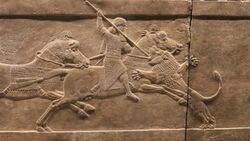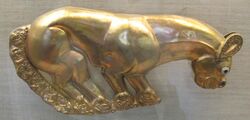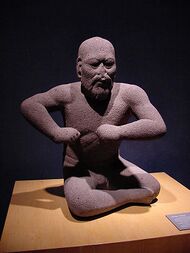1st millennium BC
Topic: History
 From HandWiki - Reading time: 9 min
From HandWiki - Reading time: 9 min
Error: No valid link was found at the end of line 2.
The 1st millennium BC, also known as the last millennium BC, was the period of time lasting from the years 1000 BC to 1 BC (10th to 1st centuries BC; in astronomy: JD 1356182.5 – 1721425.5[1]). It encompasses the Iron Age in the Old World and sees the transition from the Ancient Near East to classical antiquity.
World population roughly doubled over the course of the millennium, from about 100 million to about 200–250 million.[2]
Overview
The Neo-Assyrian Empire dominates the Near East in the early centuries of the millennium, supplanted by the Achaemenid Empire in the 6th century. Ancient Egypt is in decline, and falls to the Achaemenids in 525 BC.
In Greece, Classical Antiquity begins with the colonization of Magna Graecia and peaks with the conquest of the Achaemenids and the subsequent flourishing of Hellenistic civilization (4th to 2nd centuries).
The Roman Republic supplants the Etruscans and then the Carthaginians (5th to 3rd centuries). The close of the millennium sees the rise of the Roman Empire. The early Celtic culture dominate Central Europe while Northern Europe is in the Pre-Roman Iron Age. In East Africa, the Nubian Empire and Aksum arise.
In South Asia, the Vedic civilization gives rise to the Maurya Empire. The Scythians dominate Central Asia. In China, the Zhou dynasty rules the Chinese heartland at the beginning of the millennium. The decline of the Zhou dynasty during Spring and Autumn period and the Warring States period sees the rise of such philosophical and spiritual traditions as Confucianism and Taoism. Towards the close of the millennium, the Han dynasty extends Chinese power towards Central Asia, where it borders on Indo-Greek and Iranian states. Japan is in the Yayoi period.
The Olmec civilization declines, and the Maya and Zapotec civilizations emerge in Mesoamerica. The Chavín culture flourishes in Peru.
The first millennium BC is the formative period of the classical world religions, with the development of early Judaism and Zoroastrianism in the Near East, and Vedic religion and Vedanta, Jainism and Buddhism in India. Early literature develops in Greek, Latin, Hebrew, Sanskrit, Tamil and Chinese. The term Axial Age, coined by Karl Jaspers, is intended to express the crucial importance of the period of c. the 8th to 2nd centuries BC in world history.
World population more than doubled over the course of the millennium, from about an estimated 50–100 million to an estimated 170–300 million. Close to 90% of world population at the end of the first millennium BC lived in the Iron Age civilizations of the Old World (Roman Empire, Parthian Empire, Graeco-Indo-Scythian and Hindu kingdoms, Han China). The population of the Americas was below 20 million, concentrated in Mesoamerica (Epi-Olmec culture); that of Sub-Saharan Africa was likely below 10 million. The population of Oceania was likely less than one million people.[2]
Ancient history
Timeline
- 10th century BC
- Near East: Neo-Assyrian Empire
- Near East: Shoshenq I invades Canaan
- Aegean: Helladic period ends
- Sub-Saharan Africa West: Nok Culture slowly diffuse discernible ceramic sculpting, iron metallurgy and cereal farming cultures through the Niger Delta region, though debatable possible settling period and or foundation of proto Ile-Ife
- 9th century BC
- Chavín culture in Peru
- Egypt: 872 BC: Nile floods the Temple of Luxor
- Egypt: 836 BC: Civil war in Egypt
- North Africa: 814 BC: Carthage founded
- China: 841 BC–828 BC Gonghe Regency
- 8th century BC
- 727 BC: Egypt: Kushite invasion (25th dynasty)
- 771 BC: China: Spring and Autumn period
- Near East: 727 BC: Death of Tiglath-Pileser III, Babylonia secedes from Assyria
- Near East: 722 BC: Sargon II takes Samaria; Assyrian captivity of the Israelites.
- Greece: Archaic Greece, Greek alphabet
- Greece: Homer
- 776 BC: Greece: First Olympiad
- 753 BC: Europe: foundation of Rome
- 7th century BC
- 671 BC: Assyrian conquest of Egypt
- Near East: 631 BC: Death of Ashurbanipal, decline of the Assyrian Empire
- 6th century BC
- Egypt: 592 BC: Psamtik II sacks Napata
- Sudan: Aspelta moves the Kushite capital to Meroe
- Near East: 539 BC: Achaemenid conquest of Babylon under Cyrus the Great
- South Asia: Śramaṇa movement and "second urbanisation"
- South Asia: Early Buddhism
- Europe: 509 BC: Roman Republic
- 5th century BC
- China: 479 BC: death of Confucius
- China: 476 BC: Warring States period
- China: 486 BC: Grand Canal construction begins
- Near East: Second Temple Judaism, redaction of the Hebrew Bible
- Greece: beginning of the classical period (Greece in the 5th century BC).
- Greece: Greco-Persian Wars (Battle of Marathon, Battle of Thermopylae)
- Greece: 440 BC: Herodotus' Histories
- Greece: 431 BC: Peloponnesian War
- Oceania: Austronesian expansion reaches Western Polynesia
- 4th century BC
- Greece: 395 BC: Corinthian War
- Egypt: 343 BC: Achaemenid conquest
- Greece/Asia/Egypt: 330s BC: conquests of Alexander the Great, end of the Achaemenid Empire, Macedonian Empire, beginning of the Hellenistic period
- South Asia: Mauryan Empire
- 3rd century BC
- China: Qin Unified China
- China: 206 BC: Han Dynasty
- South Asia: 261 BC: Kalinga war
- Rome: Roman expansion in Italy
- Rome/Carthage: Punic Wars
- 264 BC: First Punic War
- 218 BC Second Punic War
- 2nd century BC
- Rome/Carthage: 149 BC Third Punic War, Roman province of Africa
- Rome/Greece: 146 BC Battle of Corinth, beginning of the Roman era
- South Asia: 185 BC: Fall of the Maurya Empire
- China: Confucianism became the state ideology of China
- 1st century BC
- China: 91 BC: Records of the Grand Historian finished
- Rome/Europe: 58–50 BC Gallic Wars
- Rome: 32/30 BC: Final War of the Roman Republic (Battle of Actium)
- Rome/Egypt: 31 BC: Roman conquest of Egypt
- Rome/Europe/West Asia/Africa: 27 BC: Roman Empire
Inventions, discoveries, introductions
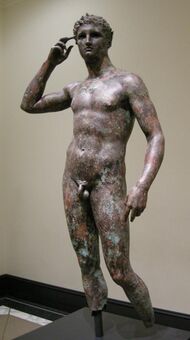
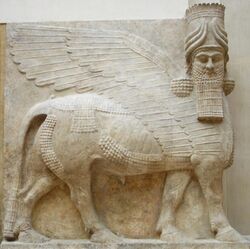
- 8th century BC
- Greek alphabet, the first alphabet with vowels.
- 7th century BC
- Trireme[3]
- 6th century BC
- 5th century BC
- Blast furnace China[5]
- Atomism
- crossbow[3]
- siege engine[3]
- 4th century BC
- formal grammar
- Kyrenia ship[3]
- 3rd century BC
- Lighthouse of Alexandria[3]
- Malleable Cast iron China[6]
- buoyancy (Archimedes)
- Spherical earth
- water clock[3]
- Qin built and unified various sections of the Great Wall of China.
- Qin built Qin Shi Huang's Mausoleum guarded by the life-sized Terracotta Army.
- 2nd century BC
Literature
- Greco-Roman literature
Archaic period
- Homer (late 8th or early 7th c.), Iliad, Odyssey
- Hesiod (8th to 7th c.), Theogony and Works and Days
- Archilochus (7th century), Greek poet
- Sappho, (late 7th to early 6th c.), Greek poet
- Ibycus
- Alcaeus of Mytilene
- Aesop's Fables
Classical period
- Aeschylus (c. 525–455 BC), Greek playwright
- Herodotus (484–425 BC), Histories
- Euripides (c. 480–406 BC), Greek playwright
- Xenophon: Anabasis, Cyropaedia
- Aristotle (384–322 BC), corpus Aristotelicum
Hellenistic to Roman period
- Septuagint
- Apollonius of Rhodes: Argonautica
- Callimachus (310/305-240 B.C.), lyric poet
- Manetho: Aegyptiaca
- Theocritus, lyric poet
- Euclid: Elements
- Menander: Dyskolos
- Theophrastus: Enquiry into Plants
- Old Latin Livius Andronicus, Gnaeus Naevius, Plautus, Quintus Fabius Pictor, Lucius Cincius Alimentus
- Classical Latin: Cicero, Julius Caesar, Virgil, Lucretius, Livy, Catullus
- Chinese literature
- I Ching (date unknown, between the 10th and 4th centuries BC)
- Classic of Poetry (Shījīng), Classic of Documents (Shūjīng) (authentic portions), Classic of Changes (I Ching)
- Spring and Autumn Annals (Chūnqiū) (722–481 BC, chronicles of the state of Lu)
- Confucius: Analects (Lúnyǔ)
- Classic of Rites (Lǐjì)
- Commentaries of Zuo (Zuǒzhuàn)
- Laozi (or Lao Tzu): Tao Te Ching
- Zhuangzi: Zhuangzi (book)
- Mencius: Mencius
- Sanskrit literature
- Vedic Sanskrit: Vedas, Brahmanas
- Vedanga
- Mukhya Upanishads
- early layers of the Sanskrit epics (c. 3rd century BC to 4th century AD)
- Hebrew
- c. 8th to 7th c.: the Book of Nahum, Book of Hosea, Book of Amos, Book of Isaiah
- c. 6th c.: Psalms
- c. 5th century: redaction of the Torah
- 3rd century: Ecclesiastes
- 2nd century: Book of Wisdom
- Avestan
- Other (2nd to 1st century BC)
- Pali literature: Tipitaka
- Tamil :Sangam literature
- Aramaic: Book of Daniel
Archaeology
| Culture | Region | Period | Notes |
|---|---|---|---|
| Urnfield culture | Europe, Central | 1300–750 BC | Bronze Age Europe |
| Atlantic Bronze Age | Europe, Western | 1300–700 BC | Bronze Age Europe |
| Painted Grey Ware culture | South Asia | 1200–600 BC | Bronze Age India, Indo-Aryan migration |
| Late Nordic Bronze Age | Europe, North | 1100–550 BC | Bronze Age Europe |
| Villanovan culture | Europe, Italy | 1100–700 BC | Iron Age Europe |
| Greek Dark Ages | Greece | 1100–800 BC | Dorian invasion |
| Iron Age II | Near East | 1000–586 BC | Ancient Near East, List of archaeological periods (Levant) |
| Sa Huỳnh culture | Southeast Asia, Vietnam | 1000 BC–AD 200 | |
| Woodland period | North America | 1000 BC – AD 1000 | List of archaeological periods (North America) |
| Bantu expansion | Sub-Saharan Africa | 1000 BC–AD 500 | |
| Middle Nok Period | Sub-Saharan Africa, West | 900–300 BC | Iron metallurgy in Africa |
| Novocherkassk culture | Europe, Eastern | 900–650 BC | |
| Chavín de Huántar | South America, Peru[7] | 1200–500 BC | |
| Poverty Point earthworks | North America, Louisiana | 1650–700 BC[7] | |
| Olmecs | Mesoamerica | 1500–400 BC | |
| Adena culture | North America, Ohio | 1000–200 BC[7] | |
| Liaoning bronze dagger culture | East Asia | 800–600 BC | |
| Middle Mumun | East Asia, Korea | 800–300 BC | |
| Etruscan civilization | Europe, Italy | 800–264 BC | |
| Paracas culture | South America, Peru | 800–100 BC[7] | |
| Hallstatt culture | Europe, Central | 800 BC–500 BC | Iron Age Europe, Thraco-Cimmerian, Celts |
| British Iron Age | Europe, Britain | 700–50 BC | Insular Celts |
| Zapotec civilization | Mesoamerica | 700 BC – AD 700 | |
| Pazyryk culture | Central Asia | 600–300 BC | Scythians, Saka, Pazyryk burials |
| Aldy-Bel culture | Central Asia | 600–300 BC | Scythians, Saka |
| La Tène culture | Europe, Central/Western | 500–50 BC | Gauls |
| Pre-Roman Iron Age | Europe, North | 500–50 BC | Proto-Germanic |
| Northern Black Polished Ware | South Asia | 500–300 BC | Vedic period |
| Late Mumun | East Asia, Korea | 550–300 BC | |
| Urewe | Sub-Saharan Africa | 400 BC–AD 500 | Iron metallurgy in Africa |
| Late Nok Period | Sub-Saharan Africa, West | 300–1 BC | Iron metallurgy in Africa |
| Nasca culture | South America, Peru | 100 BC–800 AD[7] | |
| Calima culture | South America, Colombia | 200 BC–400 AD | |
| Hopewell tradition | North America | 100 BC–AD 400[8] | |
| Teotihuacan | Mesoamerica | 100 BC –AD 550[8] | |
| Ipiutak site | North America, Alaska | 100 BC –AD 800[8] |
Astronomy
- Historical solar eclipses
| Year
(BC) |
Date | Eclipse
Type |
Saros
Series |
Eclipse
Magnitude |
Gamma | Ecliptic
Conjunction (UT) |
Geatest
Eclipse (UT) |
Duration
(Min & Sec) |
Description |
|---|---|---|---|---|---|---|---|---|---|
| 899 | 21 Apr | Annular | 53 | 0.9591 | 0.8964 | 22:32:15 | 22:21:56 | 00:03:04 | China's 'Double-Dawn' Eclipse [2] [3] |
| 763 | 15 Jun | Total | 44 | 1.0596 | 0.2715 | 08:11:13 | 08:14:01 | 00:05:00 | Assyrian Eclipse [4] [5] |
| 648 | 6 Apr | Total | 38 | 1.0689 | 0.6898 | 08:24:05 | 08:31:03 | 00:05:02 | Archilochus' Eclipse [6] [7] |
| 585 | 28 May | Total | 57 | 1.0798 | 0.3201 | 14:25:41 | 14:22:26 | 00:06:04 | Thales Eclipse (Medes vs. Lydians), firstly recorded in Herodotus History. [8] [9] [10] |
| 557 | 19 May | Total | 48 | 1.0258 | 0.3145 | 12:49:02 | 12:52:26 | 00:02:22 | The Siege of Larisa, firstly recorded by Xenophon. [11] |
| 480 | 2 Oct | Annular | 65 | 0.9324 | 0.4951 | 11:56:54 | 11:51:01 | 00:07:57 | Xerxes' Eclipse. recorded by Herodotus History. [12] |
| 431 | 3 Aug | Annular | 48 | 0.9843 | 0.8388 | 14:45:34 | 14:54:52 | 00:01:05 | Peloponnesian War. [13] [14] |
| 424 | 21 Mar | Annular | 42 | 0.9430 | 0.9433 | 07:43:30 | 07:54:29 | 00:04:39 | 8th Year of Peloponnesian War. [15] |
Centuries and decades
| 10th century BC | 990s BC | 980s BC | 970s BC | 960s BC | 950s BC | 940s BC | 930s BC | 920s BC | 910s BC | 900s BC |
| 9th century BC | 890s BC | 880s BC | 870s BC | 860s BC | 850s BC | 840s BC | 830s BC | 820s BC | 810s BC | 800s BC |
| 8th century BC | 790s BC | 780s BC | 770s BC | 760s BC | 750s BC | 740s BC | 730s BC | 720s BC | 710s BC | 700s BC |
| 7th century BC | 690s BC | 680s BC | 670s BC | 660s BC | 650s BC | 640s BC | 630s BC | 620s BC | 610s BC | 600s BC |
| 6th century BC | 590s BC | 580s BC | 570s BC | 560s BC | 550s BC | 540s BC | 530s BC | 520s BC | 510s BC | 500s BC |
| 5th century BC | 490s BC | 480s BC | 470s BC | 460s BC | 450s BC | 440s BC | 430s BC | 420s BC | 410s BC | 400s BC |
| 4th century BC | 390s BC | 380s BC | 370s BC | 360s BC | 350s BC | 340s BC | 330s BC | 320s BC | 310s BC | 300s BC |
| 3rd century BC | 290s BC | 280s BC | 270s BC | 260s BC | 250s BC | 240s BC | 230s BC | 220s BC | 210s BC | 200s BC |
| 2nd century BC | 190s BC | 180s BC | 170s BC | 160s BC | 150s BC | 140s BC | 130s BC | 120s BC | 110s BC | 100s BC |
| 1st century BC | 90s BC | 80s BC | 70s BC | 60s BC | 50s BC | 40s BC | 30s BC | 20s BC | 10s BC | 0s BC |
| 1st century | 0s | 10s | 20s | 30s | 40s | 50s | 60s | 70s | 80s | 90s |
References
- ↑ "Julian Day Number from Date Calculator". https://keisan.casio.com/exec/system/1227779487.
- ↑ 2.0 2.1 Klein Goldewijk, K. , A. Beusen, M. de Vos and G. van Drecht (2011). The HYDE 3.1 spatially explicit database of human induced land use change over the past 12,000 years, Global Ecology and Biogeography20(1): 73–86. doi:10.1111/j.1466-8238.2010.00587.x (pbl.nl). Goldewijk et al. (2011) estimate 188 million as of AD 1, citing a literature range of 170 million (low) to 300 million (high). Out of the estimated 188M, 116M are estimated for Asia (East, South/Southeast and Central Asia, excluding Western Asia), 44M for Europe and the Near East, 15M for Africa (including Egypt and Roman North Africa), 12M for Mesoamerica and South America. North America and Oceania were at or below one million. Jean-Noël Biraben, "Essai sur l'évolution du nombre des hommes", Population 34-1 (1979), 13–25 (p. 22) estimats c. 100 million at 1200 BC and c. 250 million at AD 1.[1]
- ↑ 3.0 3.1 3.2 3.3 3.4 3.5 3.6 "Who Built it First". Ancient Discoveries. A&E Television Networks. 2008. http://www.history.com/minisite.do?content_type=Minisite_Generic&display_order=5&content_type_id=60600&mini_id=52979.
- ↑ Although disputed, some scholars see the emergence of monotheism proper in the context of the Babylonian exile, during which the Israelites adopted aspects of Babylonian religion, resulting in Second Temple Judaism by 515 BC. No Other Gods: Emergent Monotheism in Israel Also credited with early monotheism is Zoroastrianism, founded at roughly the same time. Zoroastrianism
- ↑ Temple 1986
- ↑ Temple 1986, pp. 15
- ↑ 7.0 7.1 7.2 7.3 7.4 "World Timeline of the Americas 1000 BC – AD 200". The British Museum. 2005. http://www.worldtimelines.org.uk/world/americas/1000-200BC.
- ↑ 8.0 8.1 8.2 "World Timeline of the Americas 200 BC – AD 600". The British Museum. 2005. http://www.worldtimelines.org.uk/world/americas/200BC-AD600.
- Temple, Robert (1986). The Genius of China: 3000 years of science, discovery and invention. New York: Simon and Schuster. Based on the works of Joseph Needham
- Zimmer, Heinrich (1952), Joseph Campbell, ed., Philosophy of India, London: Routledge & Kegan Paul Ltd, https://archive.org/details/Philosophy.of.India.by.Heinrich.Zimmer, "Not in copyright"
 |
44 views | Status: cached on August 03 2024 17:20:05
↧ Download this article as ZWI file
 KSF
KSF

